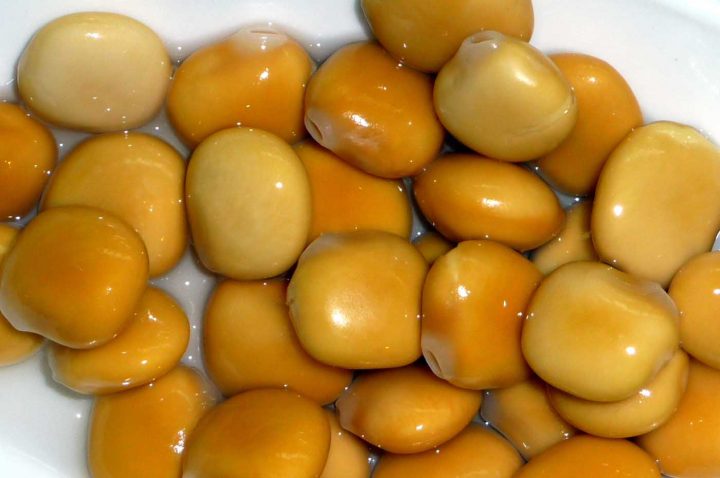Most people know lupines from the edges of highways or gardens, where their pretty candles glow in shades of red, yellow and blue. Lupines are also used for nitrogen enrichment in the fields and as protein feed for animals. But very few people know that they also have something to offer for human nutrition. The sweet lupine has played a significant role in nutrition in the Mediterranean and South American world for more than 2000 years. Above all, it provides us with protein and some trace elements and important vitamins.

The lupine belongs to the legume family and to the faboideae subgroup. It is related to the gorse. The word lupine contains the Latin word “lupus” meaning wolf. This is where the name wolf bean comes from. We know between 100 and 200 species of lupines. However, mainly the sweet lupine plays a role in nutrition, since this variety contains hardly any bitter substances that are not digestible for humans and animals. The plant has roots that can reach up to 1.5 meters into the ground. That is why it thrives quite well even on very dry soil.
Like all legumes, it can bind the nitrogen from the air with the help of the nodule bacteria on the roots. This is the basic requirement for the formation of protein. If this protein had to be produced by humans in a chemical factory, it would be a very complicated process that would require enormous machinery. The plant does this in a very small space with ingenious means. The deep rooting of the soil and the breakdown of minerals that are difficult to dissolve together with the formation of nitrogen makes the lupine so valuable as a preceding crop. In the Andes, where the lupine probably comes from, it is grown on the uppermost terraces. There it collects nitrogen, which is washed down with the rain onto the lower terraces. In this way, these fields are naturally fertilized.
Lupines and Nutrition
In South America, the lupine has been a staple food for more than 2000 years and is cultivated with intercropping together with maize and quinoa. Wild lupines are bitter and poisonous. Such protein would have to be debittered. Bitter-free cultivars include the blue-flowering varieties of the narrow-leaved Lupinus angustifolius. Sweet lupines do not contain any phytates like beans and soybeans. They can therefore also be eaten raw without harm.

Lupine protein is a very valuable protein, especially for vegetarians or vegans. It is low in purine, so it hardly forms any uric acid, which is a major disadvantage with soybeans. It is perfect as a protein source for people with rheumatic diseases or gout. It is also low in glycemic index, which is beneficial for the diabetic as the carbohydrates are released gradually. The blood sugar level rises slower. In addition, it is lactose and gluten free, an advantage for lactose intolerant people and celiacs.
The protein composition is such that there are significant amounts of the essential amino acids lysine, methionine and tryptophan, more than in beans and peas. Only the soybean has more to offer in this respect. Combined with grain or corn, the lupine protein is an excellent source of protein that is far superior to animal protein because it hardly forms any uric acid. In addition, the lupine seeds contain important fatty acids such as linoleic acid, oleic acid and lecithin. Unlike soybeans, lupine seeds do not have to be degreased before they are made into lupine flour or lupine tofu. Therefore, these important fatty acids are also contained in the end product and thus also vitamin E and carotenoids. Lupine is a good source of iron and calcium.
Lupines versus Soybeans
Lupines compare very well with soybeans. In addition, lupines are not genetically modified. The genetic diversity of the many species of lupine makes it possible to obtain desired properties simply by breeding. In the case of soybeans, up to 60% of the entire production worldwide is already grown from genetically engineered seeds. Sweet lupine is therefore a good alternative to soy, both for agriculture and for animal and human nutrition.
Allergy
Unfortunately, lupine also has a certain potential for allergy. People who are allergic to peanuts frequently show allergic reactions to lupines as well. For this reason, processed products containing lupine flour or other lupine ingredients must be properly labeled.
Lupine Products
The uses of the lupine seeds are very diverse. In the Andes, a stew called tarwi is made from it. In Egypt and Algeria, street vendors offer a snack made from the seeds, and the Portuguese like to nibble lupines treated in brine.

Fortunately, the range of products on the domestic market is also growing. Lupine flour and meal are increasingly being added to pasta and baked goods as a dietary fiber supplement. The carotenoids in the flour also result in a rich yellow color and the emulsifying effect of the lecithin increases the stability of the dough. Bread is enriched with lupine flour. There is lupine milk and ice cream. One advantage over soy products is that the lupine protein doesn’t taste like beans. The lupine tofu “Lopino” is popular and can be used sweet or savory. But you have to marinate it very well. There are also spreads, desserts, burgers and even a coffee substitute.
Recommendation
Diet reports recommend eating more plant-based protein. The advantage of protein obtained from the lupine is obvious. We just have to use it consciously. There are already plenty of recipes available on the Internet.
Recipes
Lupine Cheese
- 1 cup lupine seeds (in brime)
- 1 Tbs yeast flakes
- 6 tsp agar agar
- juice of half a lemon
- 2 Tbs olive oil
- ½ clove of garlic
Cook the agar agar in 3 cups of water over low heat, stirring constantly.
Blend with the rest of ingredients.
Pour into a greased form.
Cover and chill in the fridge for 2 hours.
Protein Spread
- 200 g chickpeas
- 100 g peeled lupine beans (in brime)
- 100 g avocado
- 25 g toasted almonds
- 1 Tbs olive oil
- lemon juice (to taste)
- parsley or majoram (to taste)
Grind the lupine seeds in a food processor, then add the avocado and olive oil until it forms a paste.
Toast and grind the almonds.
Mix with the rest and season with lemon juice and herbs.
Lupine Cream Cheese
- 2 cups lupine seeds (in brime)
- ½ cup water
- 1 Tbs lemon juice
- 2 Tbs olive oil
Blend all ingredients.
Season with more salt if necessary.
Mediterranean Lopino Ragout
Marinade:
- 1 cup Lopino (Lupine Tofu)
- 3 cloves of garlic (crushed)
- 1 branch rosemary (minced)
- 2 Tbs lemon juice
- 2 Tbs water
- 3 Tbs olive oil
- a pinch of salt
Vegetables:
- 1 medium zucchini (in cubes)
- 1 big eggplant (in cubes)
- 4 large peeled tomatos (in cubes)
- 1 big onion (minced)
- a few black olive
- 1/8 l vegetable broth
- thyme, majoram, basil, salt
- 2 Tbs olive oil
Mix all the ingredients for the marinade well and marinate the Lopino cubes in it for one hour.
Sauté onion in some water.
Add all ingredients except tomatoes, olives and oil.
Steam until soft for a few minutes, then add the tomatoes and olives, bring to the boil again briefly and season to taste.
Carefully mix in the lopino cubes and the 2 tbsp olive oil, serve immediately.
Combines well with whole wheat pasta, rice, couscous or bulgur.

Stay Always Up to Date
Sign up to our newsletter and stay always informed with news and tips around your health.

Esther Neumann studied Nutrition at the University of Vienna. Since then she served as an author for the health magazine “Leben und Gesundheit” and conducted health lectures in various locations of Austria.
Leave a Reply